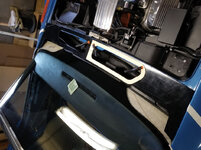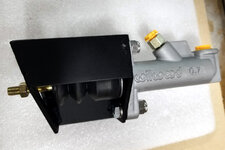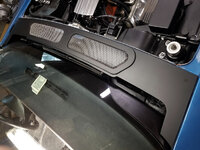You are using an out of date browser. It may not display this or other websites correctly.
You should upgrade or use an alternative browser.
You should upgrade or use an alternative browser.
Long Overdue Progress! Making New Door Panels 12/8/24
- Thread starter BBShark
- Start date
April 2020
Engine bay complete (with the exception of clutch, brake booster and throttle cable)
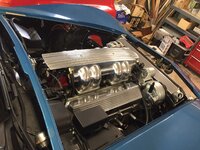
Top and bottom hose to engine/radiator and heater hoses are done. Took a bit to complete the lower hose. Needed to splice a T into the hose for a return from the heater core to the engine.
Hydraulic clutch in progress. Had to make a bracket to attach the Wilwood cylinder to the firewall.
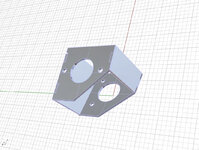
Brakes. No progress on the brakes but I did get the parking brake installed. The spot calipers I'm using resulted in the cable being too long. I need to fab up an adjuster yoke that locks onto the cables. This is made more complex because the exhaust crossover is underneath the yoke.
Throttle cable. Waiting to get the clutch and brake booster installed to route the cable.
Alternator wiring is done.
Also closed up the transmission tunnel and started the new console and wiper well cleanup.
Engine bay complete (with the exception of clutch, brake booster and throttle cable)

Top and bottom hose to engine/radiator and heater hoses are done. Took a bit to complete the lower hose. Needed to splice a T into the hose for a return from the heater core to the engine.
Hydraulic clutch in progress. Had to make a bracket to attach the Wilwood cylinder to the firewall.

Brakes. No progress on the brakes but I did get the parking brake installed. The spot calipers I'm using resulted in the cable being too long. I need to fab up an adjuster yoke that locks onto the cables. This is made more complex because the exhaust crossover is underneath the yoke.
Throttle cable. Waiting to get the clutch and brake booster installed to route the cable.
Alternator wiring is done.
Also closed up the transmission tunnel and started the new console and wiper well cleanup.
May 2020
Spring house projects have slowed my pace but I did get some stuff done.
Installed headlights and wiring. Wired alternator.
Radiator and heater hoses done.
Replaced all relays with diode protected relays
Clutch bracket was welded backwards. Completely my fault (I blame my dyslexia).
Parking brake installed but I will need to come up with a mechanism to control the cable pull.
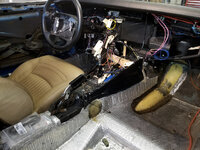

Spring house projects have slowed my pace but I did get some stuff done.
Installed headlights and wiring. Wired alternator.
Radiator and heater hoses done.
Replaced all relays with diode protected relays
Clutch bracket was welded backwards. Completely my fault (I blame my dyslexia).
Parking brake installed but I will need to come up with a mechanism to control the cable pull.


69427
The Artist formerly known as Turbo84
- Joined
- Mar 30, 2008
- Messages
- 3,077
- Reaction score
- 38
Car's looking beautiful. :thumbs:
What's the details on the steering wheel/column?
What's the details on the steering wheel/column?
Car's looking beautiful. :thumbs:
What's the details on the steering wheel/column?
The steering wheel is from a 1990 and the column is from a 1996. I used to have a 90 and I always liked the ergonomics and driving position so I tried to replicate that.
My plan is to fabricate a piece to replace the airbag that makes it look a little more "vintage".
http://www.vettemod.com/forum/showthread.php?t=11655
bobs77vet
Well-known member
very nice, what does a diode protected relay protect against?
diodes only allow for a one way travel of electricity correct? so does this stop inadvertent back flow of circuits hunting for a ground?
diodes only allow for a one way travel of electricity correct? so does this stop inadvertent back flow of circuits hunting for a ground?
very nice, what does a diode protected relay protect against?
diodes only allow for a one way travel of electricity correct? so does this stop inadvertent back flow of circuits hunting for a ground?
best explanation from 69427:
After I was done with mine a friend asked me if I used diode protected relays. I never even heard of such a thing. So, I searched the internet for information about diode protected relays for radiator fans. Despite the incredible amount of "information" I found, I don't think I know anything more that I did a month ago. I trust your opinion on this. Do you know if relays with diodes are needed?
Relays with diodes are more flexible regarding the switch that tells the relay to turn on, and are preferred when available. The winding part of the relay acts just like a miniature ignition coil when connected to a mechanical switch (which acts like a set of distributor points) or a transistor. When the mechanical switch is opened, the magnetic field in the relay winding collapses, causing a high voltage spike across the switch (just like a set of points will arc if the condenser isn't there). The diode, connected across the windings, lets the relay winding current recirculate through the windings, causing the magnetic field to collapse slower, reducing or eliminating the arc. This protects the contacts of the control switch (the fan temperature switch, for example), or the transistor in an electronic fan controller.
At a minimum, the relays should have a resistor across the relay windings (to allow a recirculation path), but a diode is certainly preferred.
Is there a "schematic" of the relay internals printed on the housings of the relays you're using?
phantomjock
Well-known member
Very NICE! Is that money on the dash to reference the "scale?"
Looking forward to the completed pictures.
Cheers - Jim
Looking forward to the completed pictures.
Cheers - Jim
Very NICE! Is that money on the dash to reference the "scale?"
I found that dollar under the seat in 2003 and a New Jersey Turnpike token under the carpet. I am going to put them back when I install the carpet. Not sure why because I don't expect someone will find it when they do a restoration in 25 years. The way things are going, I expect this car will be seized and crushed before then.
SRountree
Well-known member
Very nice work
June 2020
Not so much visible progress this month.
In preparation of startup, I was able to finish plumbing the radiator/overflow/heater core and fill with coolant. No leaks! All wiring is in. Nothing on the interior except for buying carpet. Wiper well cover and windshield extensions done.
The hydraulic clutch is really kicking my ass. I installed the bracket and cylinder only to find that it interferes with the brake booster, so will have to modify that.
Next on the list is some welding of bumper supports and install braces. Install clutch, brake booster and throttle cable. Also finish parking brake. Start installation of carpet and mock up console.
June 2020
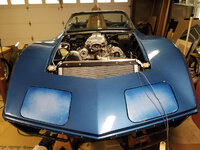
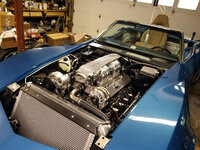
Not so much visible progress this month.
In preparation of startup, I was able to finish plumbing the radiator/overflow/heater core and fill with coolant. No leaks! All wiring is in. Nothing on the interior except for buying carpet. Wiper well cover and windshield extensions done.
The hydraulic clutch is really kicking my ass. I installed the bracket and cylinder only to find that it interferes with the brake booster, so will have to modify that.
Next on the list is some welding of bumper supports and install braces. Install clutch, brake booster and throttle cable. Also finish parking brake. Start installation of carpet and mock up console.
June 2020


MYBAD79
Moderator
Nice work.... now that you have this part fitting good, why not buy a gallon of mold foam and make a mold to replicate this ? Guess you can make the mold for under $100 and making a piece from fiberglass resin and mat would probably be $25 .... I would think these would sell for $150 a pop.... easily....
I just made C6 widebody conversion inner fender extensions, made one extra pair and then removed the form/mold from my stock inner fenders... installed my set ... then sold the second set I made for $200 within two days of posting it.... kicking my ass form not making a foam mold.... :smash:
I just made C6 widebody conversion inner fender extensions, made one extra pair and then removed the form/mold from my stock inner fenders... installed my set ... then sold the second set I made for $200 within two days of posting it.... kicking my ass form not making a foam mold.... :smash:
This wouldn't work on a 73-up long hood car because of the way the hood is made. I am making my own hood so I don't have that problem. Also the perforated metal screens are draw formed and my tooling to make them is temporary (and it lasted for only 2 parts).
bobs77vet
Well-known member
Thanks for the explanation, I can see where the diode would be helpful for high amp circuits that cycle a lot. are those C5 seats that you are going to use?
Yes, I'm going to use C5 Sport Seats. Found 2 in great condition about 10 years ago.
Not much visible progress this month. I started putting the front braces and extensions on and found that they ultimately attach the the bumper and the bumper doesn't fit the car at all due to previous body work. So I will need to do some rework to the front end.
The clutch cylinder is still not done. This thing is the project will no ending! I need to do this before I put the booster in. So, it is pretty much holding up everything needed to make it a driveable car.
Not much visible progress this month. I started putting the front braces and extensions on and found that they ultimately attach the the bumper and the bumper doesn't fit the car at all due to previous body work. So I will need to do some rework to the front end.
The clutch cylinder is still not done. This thing is the project will no ending! I need to do this before I put the booster in. So, it is pretty much holding up everything needed to make it a driveable car.



